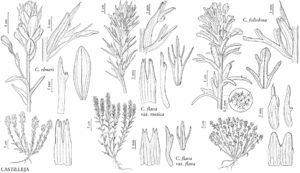Castilleja foliolosa
Bot. Beechey Voy., 154. 1833.
Herbs or subshrubs, sometimes shrubs, perennial, 1.2–6 dm; from a woody caudex; with a taproot. Stems many, ascending, white or grayish due to hairs branched, much-branched proximally, unbranched to sometimes branched on distal 1/2, also usually with short axillary branches, base often shrubby and with marcescent leaves of previous year, hairs dense, appressed to spreading, medium length, soft, much-branched, eglandular, white-woolly, obscuring surface. Leaves whitish or grayish, linear to narrowly lanceolate or narrowly oblong, 0.9–5 cm, not fleshy, margins plane, involute, 0–3-lobed, apex obtuse to rounded; lobes divergent, spreading, linear, apex acuminate to acute. Inflorescences 2.5–20 × 1.5–3 cm; bracts proximally green to dull pale purplish, distally red, scarlet, rose, yellow, orange, or cream, sometimes pink or white, lanceolate to oblanceolate, (0–)3–5-lobed; lobes spreading, or distal ones erect, often oblanceolate, if 5-lobed, distal lobes usually very shallow, long or distal short, proximal bracts arising below mid length, distal ones arising near apex, apex rounded to truncate. Calyces proximally green, apices colored as bracts, 14–20(–22) mm; abaxial and adaxial clefts 3.5–7(–9) mm, 33–40% of calyx length, deeper than laterals, lateral 0(–1) mm, 0(–7)% of calyx length; lobes broadly triangular, apex of lobes and segments broadly rounded to truncate, segments, if present, obtuse. Corollas straight or slightly curved, 16–27 mm; tube (8–)10–12(–14) mm; beak exserted or partially so, adaxially green, (7–)8.5–14 mm; abaxial lip deep green, reduced, 1–3 mm, 20–33% as long as beak; teeth incurved, reduced, green, 0.5 mm. 2n = 24.
Phenology: Flowering Jan–Jul.
Habitat: Chaparral, dry rocky slopes, coastal scrub, open forests.
Elevation: 0–1900 m.
Distribution
Calif., Mexico (Baja California).
Discussion
Castilleja foliolosa inhabits chaparral from northern California southward to northern Baja California, west of the Sierra Nevada crest. The inflorescence is usually red or red-orange but can vary to white, yellow, pink, or purple. It is present on Santa Catalina Island in the southern Channel Islands, Los Angeles County, but is replaced in the northern Channel Islands by C. hololeuca, a related shrubby species. Castilleja foliolosa hybridizes with C. martini var. martini in San Diego County.
Selected References
None.
